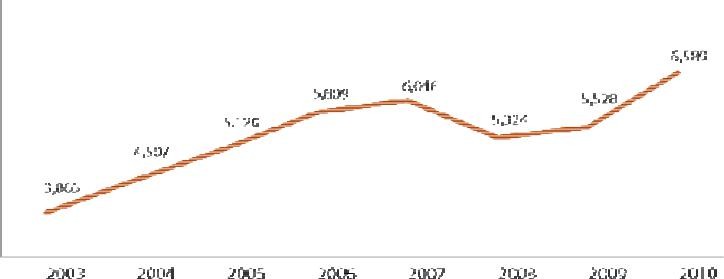By Terry Sovil from the August 2012 Edition
In this final article on the “Real Mexico” we will take a look at the Electrical Industry. This comprises companies that manufacture home appliances and transmission/ distribution and control of power (transformers, generators, switches, regulators and engines).
Mexico’s competitive advantages have attracted investments from large companies which contribute to continued success as well as positioning Mexico as a top producer.
From 2003 to 2010 the gross domestic product grew at a compound annual rate of 7.9%. This pushed it from 3.9 billion dollars to 6.6 billion dollars. In 2010 the electrical industry gross domestic product accounted for .6% of the national gross domestic product.

Mexico enjoys a lead position as an exporter of split-door refrigerator/freezers and is the 3rd exporter of 1,500W vacuum cleaners. In 2010 Mexico’s electrical industry exported 21.201 billion dollars while retaining a trade surplus. From 2003-2010 exports compound annual growth rate was 9.5%. Global Trade Atlas reports that in 2010 most exports were to the USA and Canada, accounting for 92% of the total amount. The remaining 8% went to Columbia, Brazil and the Netherlands. The main exports were split-door refrigerators/freezers, air conditioning and lamps and other lighting.
Attraction of Foreign Direct Investment

The Ministry of Economy (SE) reports that from 2000 to 2010 the accumulated investments in the electrical industry hit 7 billion dollars. This was in the manufacture of electric materials and accessories as well as the production and assembly of home appliances. In 2010 alone foreign investments reach 504 million dollars. Countries of origin were Germany, Costa Rica, the Netherlands, France and the USA.
Companies established in Mexico
Mexico is home to over 1200 economic units from the electrical industry. Close to 260 focus on home appliances. Manufacturing facilities are located mainly in Baja California, Chihuahua, Nuevo León, the State of Mexico and Tamaulipas. These areas employ about 160,500 people.
Companies of note that have established a presence in Mexico include Panasonic, LG Electronics, Whirlpool, Electrolux, Cooper Industries, Eaton Corporation and General Electric.
Strengths of the Mexican Electrical Industry
Talent. According to ANUIES, there are more than 790 thousand higher education students enrolled in engineering and technology programs. In addition, every year more than 90 thousand students graduate from those programs.
Experience.
The first plants of the industry were established in Mexico at the end of the 1950s. Over five decades of experience have led to excellent technical and administrative capacities. Logistics Access. Important advantages can be gained from Mexico’s closeness to the North American market
The Electronics Industry
The electronics industry focuses on products such as flat screen televisions, cellular phones, computers, data processing system equipment, control units or adaptors, parts for telephones and transmission and reception devices, automatic data processing machines, microwave or satellite signal receptors, modular circuits and video game consoles.
Between 2003 and 2010, the GDP of the electronics industry grew at a compound annual rate of 1.2%, going from 7 billion dollars to 7.589 billion dollars. According to INEGI, the industry GDP in 2010 accounted for 0.7% of the national GDP.
In 2010, exports from the electronics industry accounted for 28% of the country’s non-oil exports, with 71.404 billion dollars. From 2003 to 2010, exports grew at a compound annual rate of 17.5%.
According to Global Trade Atlas, in 2010 the most important export destination for the electronics industry was the United States, which accounted for 84% of the total. The rest went mainly to Canada, Colombia and the Netherlands. The main electronic products exported by Mexico were flat screen televisions, computers and mobile phones. In 2010, Mexico ranked first globally in export value of flat screens, above countries such as China, Germany and the United States.
Attraction of Foreign Direct Investment
According to the Ministry of Economy (SE), between 2000 and 2010, the accumulated foreign direct investment in the electronics industry reached 20.625 billion dollars, being mainly for computer and peripheral equipment manufacturing.
In 2010 alone, foreign direct investment in this industry reached 1.301 billion dollars, primarily from the Netherlands, the United States, Japan, Germany and Canada.
Companies Established in Mexico
In Mexico there are more than 728 economic units belonging to the electronic industry. Manufacturing companies are mainly located in Baja California, Chihuahua, and Tamaulipas, employing around 258,000 people across the country, according to INEGI.
Among the internationally renowned companies established in Mexico figure Jabil, Lenovo, Samsung, Flextronics, FIH, Nokia, Philips and Panasonic.
Strengths of the Mexican Electronic Industry
Talent
As mentioned in all of the articles there are more than 790,000 students in higher education programs in technology and engineering. Of that number close to 90,000 students graduate from those programs each year.
Competitive Costs
Mexico remains a country with low operating costs in electronic equipment according to KPMG (international finance and accounting company).
Logistics Access
Mexico has a big advantage due to the closeness of the North American market.
Download the full edition or view it online
—
Terry is a founding partner and scuba instructor for Aquatic Sports and Adventures (Deportes y Aventuras Acuáticas) in Manzanillo. A PADI (Professional Association of Dive Instructors) Master Instructor in his 36th year as a PADI Professional. He also holds 15 Specialty Instructor Course ratings. Terry held a US Coast Guard 50-Ton Masters (Captain’s) License. In his past corporate life, he worked in computers from 1973 to 2005 from a computer operator to a project manager for companies including GE Capital Fleet Services and Target. From 2005 to 2008, he developed and oversaw delivery of training to Target’s Loss Prevention (Asset Protection) employees on the West Coast, USA. He led a network of 80+ instructors, evaluated training, performed needs assessments and gathered feedback on the delivery of training, conducted training in Crisis Leadership and Non-Violent Crisis Intervention to Target executives. Independently, he has taught hundreds of hours of skills-based training in American Red Cross CPR, First Aid, SCUBA and sailing and managed a staff of Project Managers at LogicBay in the production of multi-media training and web sites in a fast-paced environment of artists, instructional designers, writers and developers, creating a variety of interactive training and support products for Fortune 1000 companies.





You must be logged in to post a comment.